Webflow vs. WordPress: Which Website Platform Is Better?
WordPress remains the world's most popular content management system (CMS), but it's not without challengers. Webflow is a no-code WordPress alternative that's increasingly popular among developers and designers. So, which is the best option for building a website in 2024?
We took a closer look at both solutions to help you decide which platform is best for your specific project needs.
Brief Overview
What Is WordPress?
WordPress is a content management system (CMS) that enables users to create and manage web-based content. Using WordPress, you can develop just about any kind of website, even if you don't have any web design or programming skills.
Calling WordPress a CMS is a bit of an understatement, though — because it's unparalleled in popularity in use, many call it the CMS. According to some estimates, it powers around 40% of the world's ten million biggest websites, with none of its peers coming anywhere near that figure. Among our sample of websites that we could identify a CMS for, more than 75% rely on WordPress.
There are several reasons for WordPress's success: It's open source and free, can be used by anyone, regardless of their level of experience, and has a huge and active user/developer community. WordPress also offers a massive assortment of plugins and themes, which make it possible to customize the look and functionality of your WordPress website to your exact needs.
All of the above makes WordPress a powerful CMS that can power just about any kind of website project, from basic blogs and intricate business websites to online stores, or even discussion boards.
When we say WordPress, we're referring to WordPress.org, the open-source and free CMS used to create websites. If you want to publish a website and get it online, you'll also need hosting and a domain, which cost extra.
WordPress.com is a subscription-based WordPress hosting service. Users pay a monthly fee to have the technical aspects of their WordPress projects taken care of. WordPress.com, which includes hosting and a domain along with its CMS, is comparable to Webflow (other website builders like Wix or Squarespace) in that regard.
What Is Webflow?

Webflow is a web design and development platform that combines the features of a CMS with the flexible design options offered by website builders. You can visually design entire websites in Webflow's editor without having to write a single line of code.
While Webflow provides a higher degree of flexibility and customization, it also introduces a layer of complexity not found in more straightforward platforms like Wix.
This is because Webflow does not completely abstract away the programming aspect; instead, it visualizes programming processes. Understanding the logic behind coding can be beneficial, as Webflow translates these concepts into visual actions.
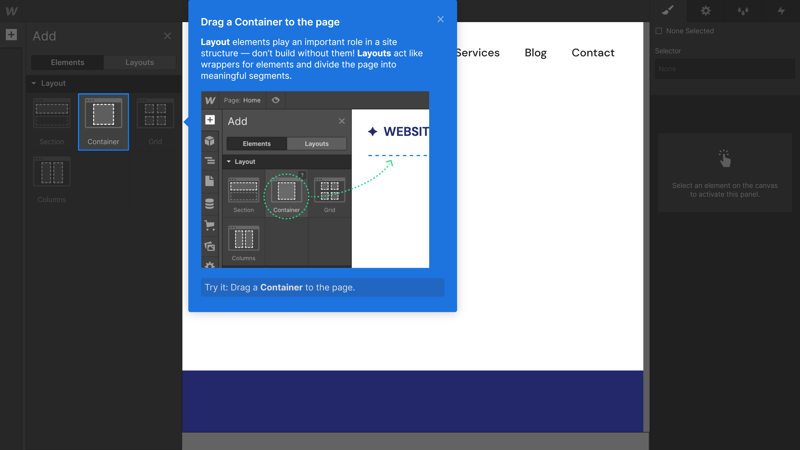
Webflow's website builder.
Webflow's approach makes it particularly attractive for designers who want greater control over the layout and functionality of their websites, without the risk of getting lost in code. A CMS for managing content, as well as hosting and a domain, are included in Webflow's subscriptions.
WordPress vs. Webflow: Which Does What Better?
Which website platform is better? The answer depends entirely on your requirements, your skills, and what you want to achieve with your website. Let's take a closer look at how the two rivals differ from one another in several key areas:
Usability
Both website platforms try to make designing a website as easy and user-friendly as possible. Their approaches, however, are quite different.
How User-Friendly Is WordPress?
WordPress is what you make of it. It's extremely versatile, but to take full advantage of what it has to offer, you'll need to be familiar with coding languages like HTML and CSS.
But if you're happy to stick to the basics and integrate features with plugins and add-ons, instead of building them yourself, you can use much of the platform without such coding knowledge.
Setting up WordPress is slightly more complicated than getting started with Webflow, since WordPress is not a managed service. First, you'll need to sort out your hosting needs and install WordPress on your web space.
Fortunately, many hosting providers offer straightforward software installers that essentially automate the WordPress installation process. Alternatively, you can opt for a dedicated WordPress hosting service, which specializes in managing WordPress projects.
You'll oversee your WordPress projects — managing your domain, backups, SSL protection, website performance, and other aspects — through your hosting provider's admin dashboard.
To work on your WordPress website's content, you'll need to head over to your WordPress admin dashboard, which looks like this:
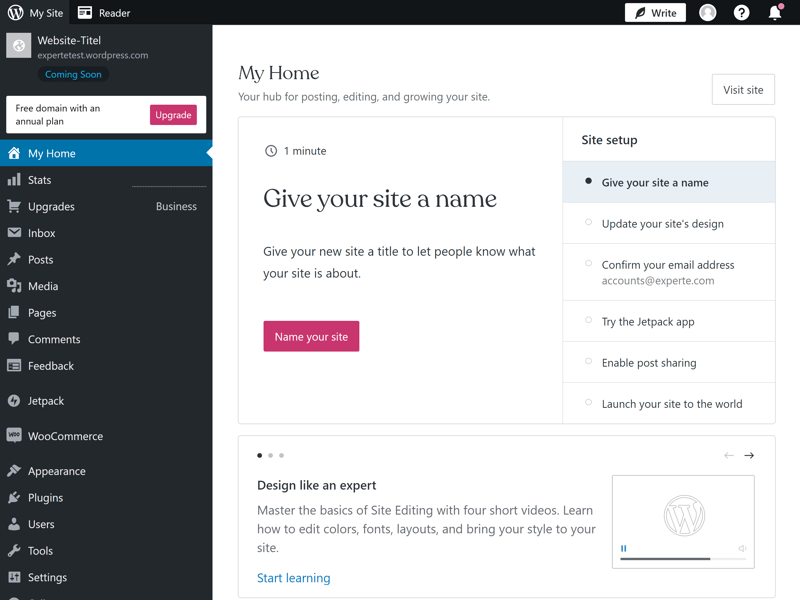
You'll probably spend quite a bit of time in your WP admin dashboard.
The WP admin dashboard is your central hub for all the features and tools needed to design and manage your website, including:
Themes: These are the visual basis for your WordPress website. They include ready-made designs, layouts, and elements, that help to customize your website's appearance. Head over to the theme repository to install a WordPress theme.
Plugins: When you install WordPress plugins, you add new features and capabilities to your WordPress website. You can even add a website builder plugin (like Elementor), which transforms WordPress into a visual website builder.
Structure and navigation: Head to Appearance > Menus to adjust your website's structure and navigation menus.
Editor: The Gutenberg editor is where you'll craft your site's content, using a block-based approach similar to that of website builders. Here, you can insert various blocks — text, images, buttons, etc. — and populate them with content.
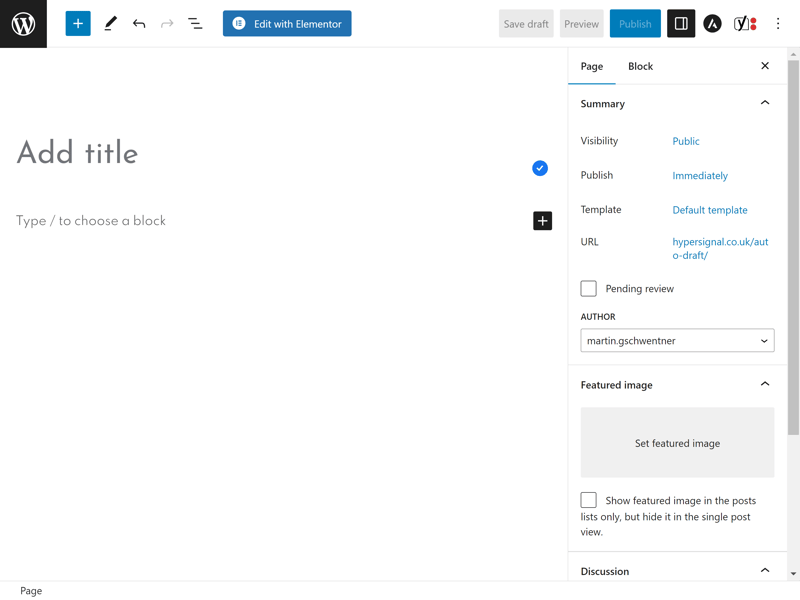
The new Gutenberg editor makes it easy to add content.
Overall, the learning curve with WordPress isn't as steep as with Webflow, since the platform accommodates users of all experience levels and doesn't require programming or coding knowledge. However, having those skills will help you make the most out of WordPress.
How User-Friendly Is Webflow?
From a tech and admin perspective, the initial Webflow setup is simple, since aspects like hosting and a domain are included in the platform subscription. Once you're registered, you can start designing your Webflow website with the platform's editor right away.
Webflow's editor is significantly more complex than those of other website builders like Wix or Squarespace. While you don't necessarily need programming knowledge to use it, its underlying logic is based on web design and coding principles.
This means that you have access to advanced design elements and features that enable precise control over layout, animations, and interactive elements. However, this additional control and flexibility require a deeper understanding of the principles of web design — and it’ll take a while to master these tools.
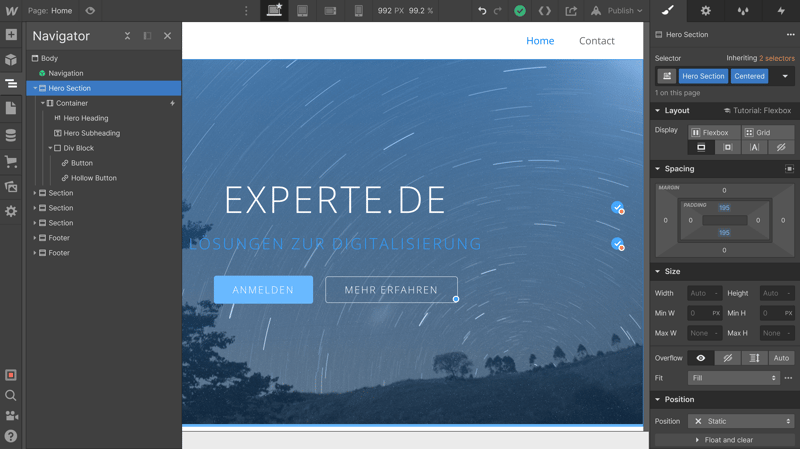
The Webflow interface looks a bit like Photoshop.
While undoubtedly complex, Webflow's editor is generally user-friendly. It has a clear, well-structured interface that guides users through every step of the design process.
This makes it an attractive option both for beginners who are ready to invest a bit of time into understanding the platform and more experienced designers.
The learning curve with WordPress isn’t as steep, but you have to manage technical aspects yourself that Webflow takes care of as part of its managed services. Webflow is a bit more complicated, especially for beginners, but its editor's design functions can save users a lot of time in the long term. Additionally, you don't have to worry about hosting, domains, or maintenance.
Customization
Webflow offers plenty of freedom and flexibility, but it simply can't compete with WordPress.
How Customizable Is WordPress?
With WordPress, the possibilities are endless: If you can dream it, you can do it, so long as you have the necessary skills or can find a suitable plugin, theme, or add-on.
There are more than 11,000 free and installable themes in the WordPress repository. Moreover, there are many more premium themes and others offered by third parties you can install manually.
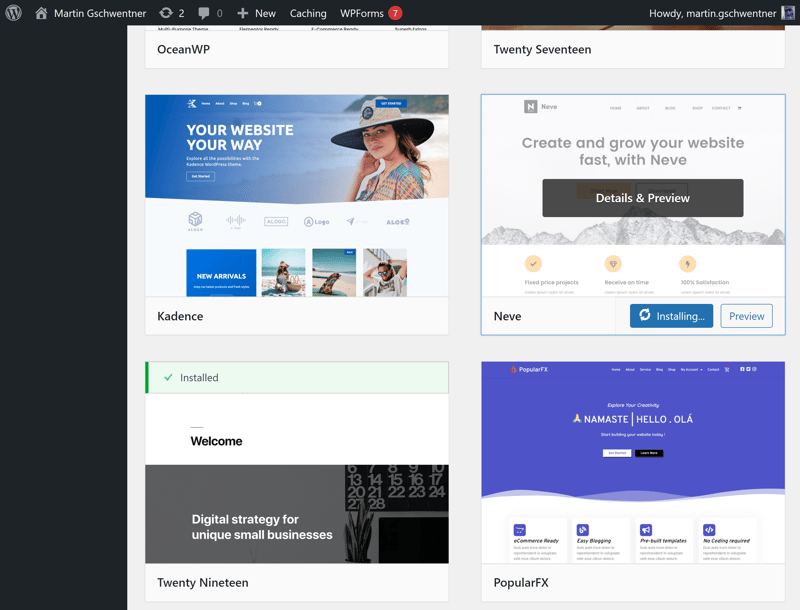
WordPress offers a massive selection of themes.
The assortment of plugins is just as large and diverse, with options for SEO, social media, contact forms, backups, caching, and even full-fledged website builders.
And if the pre-installed or ready-made tools aren't enough, you can customize your web pages with CSS or HTML (or pay a professional programmer to do it for you). As such, WordPress offers nearly total flexibility.
How Customizable Is Webflow?
Webflow also offers an impressive selection of design templates, 2,000 to be exact. There are options for blogs, portfolios, ecommerce websites, and everything in between — you'll have to pay for most of them, though. In addition, unlike with WordPress, it isn't possible to simply switch between templates.
You can integrate other services into Webflow by adding custom code (Webflow University maintains a list of supported plugins and integrations), but there's no equivalent to WordPress's extensive plugin library.
Webflow has a powerful editor, which gives you plenty of tools to adjust and customize any theme to your liking. However, Webflow doesn't match the breadth of features and options WordPress provides right out of the box.
WordPress definitely wins this round: No other website builder, even a clever hybrid solution like Webflow, offers more flexibility than the world's most popular CMS. Its selection of themes, plugins, and integrations is unrivalled.
Ecommerce
Want to create an online store? You can go with either solution — but once again, WordPress has a slight edge.
How Good Is WordPress for Ecommerce?
You can add ecommerce features to WordPress via a plugin, the most popular being WooCommerce. It's easy to set up and well-suited for both small and larger store projects. All important features, from payment gateways to delivery options, can be easily configured in the WooCommerce backend.
WooCommerce is free, just like WordPress, but you'll need to pay for your WordPress hosting and your shop's domain (on top of other ecommerce costs, such as payment fees). To make things easier, you can choose a WooCommerce hosting package that's specifically tailored to the plugin's needs.
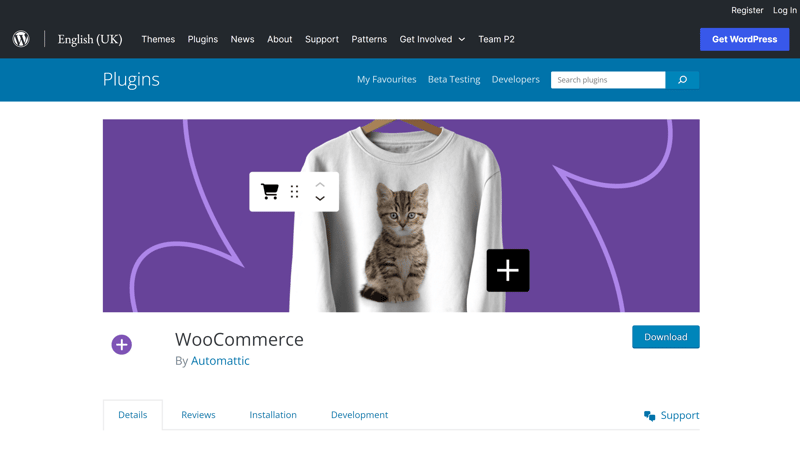
WooCommerce is an ecommerce solution developed by Automaticc, a company owned by one of WordPress's founders.
Of course, WooCommerce isn't the only option: There are plenty of other WordPress ecommerce plugins, making WordPress a great choice for any kind of ecommerce project.
How Good Is Webflow for Ecommerce?
Ecommerce features are natively integrated into Webflow — as long as you select one of its three ecommerce subscription plans (more on these below). You can create shops with up to 15,000 products.
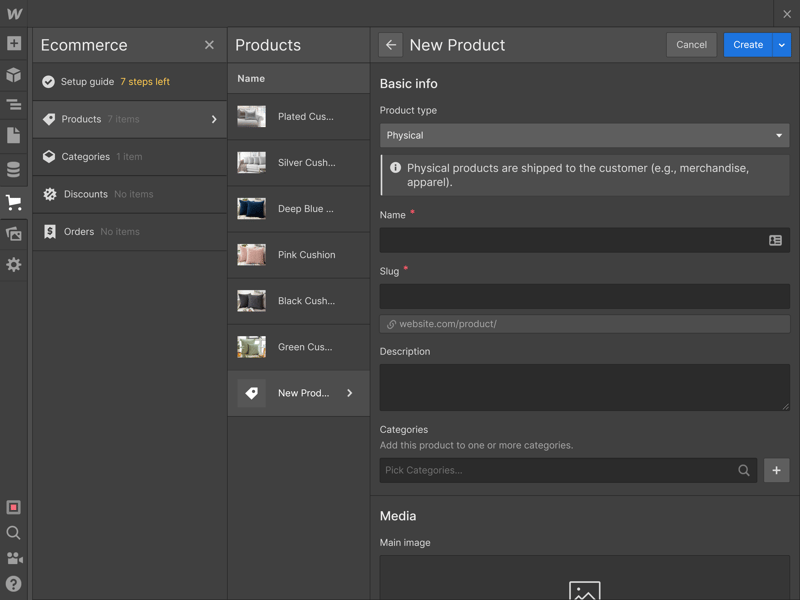
Webflow comes with integrated ecommerce features.
Webflow provides all the tools you'll need to set up a basic shop, from product management features and a shopping cart to marketing tools and integrations for Mailchimp or Google Shopping. Compared with WordPress and WooCommerce, however, the options are relatively limited.
Webflow comes with everything you'll need to set up a small to medium-sized online store. WordPress offers a wide selection of ecommerce plugins, including WooCommerce, and is significantly more flexible.
Costs
The different pricing models of WordPress and Webflow make a side-by-side comparison difficult. Let's look at the costs of each platform:
How Much Does WordPress Cost?
As mentioned above, the WordPress software itself is free. Getting a WordPress website online, however, isn't. The main cost is hosting, with prices differing across providers. Among the nine WordPress hosting services we evaluated, the most affordable subscriptions span from $5 to $40 per month. Standard hosting services, which are not specifically tailored for WordPress, tend to be a bit cheaper.









Keep in mind that these are the cheapest options, which often limit server space, performance, or other features. Depending on the size of your website project and the resources it requires, you might want or have to pay quite a bit more.
And hosting isn't the only source of cost, either. With a WordPress website, you'll also want to budget for:
Domains: Some — but not all — hosting providers include a free domain for the first year. Generally, domain costs vary depending on the domain name and ending. A .com domain costs around $10-20 per year.
Plugins: If you need a feature that's only offered by a paid plugin, you'll have to factor these costs into your budget. Plugin costs can vary, from zero to $500 or more per plugin per year.
Themes: Not all themes are free. Expect to pay anywhere from $20 to $200 for a premium theme.
WordPress offers options for every budget: You can create a simple website with a minimal investment, or to launch a large and resource-intensive project at a much higher cost.
How Much Does Webflow Cost?
Costs are easier to determine with Webflow, since its subscription packages include specific features and resources. Simply make a list of what you need for your website and purchase the subscription that best suits your requirements.
There are five basic subscriptions:
Free: This plan is mostly an option for private projects or staging websites. It comes with a Webflow.io domain and allows users to create a website with up to 2 pages and 50 CMS elements.
Basic ($13/month): According to Webflow, this plan is ideal for simple, static websites. It includes a custom domain, up to 150 pages, and 500 monthly form submissions. With 50 GB of bandwidth and 250,000 visitors per month, this plan is designed for websites expecting moderate traffic.
CMS ($23/month): This subscription is optimized for blogs or other content-oriented websites. It includes a custom domain, up to 150 pages, 2,000 CMS elements, 1,000 monthly form submissions, and allows you to designate up to 3 content editors. Subscribers also get 200 GB of bandwidth and up to 250,000 unique site visitors per month.
Business ($39/month): The Business subscription is designed for larger websites. It comes with a custom domain, up to 150 pages, 10,000 CMS elements, and 2,500 form submissions per month. Since you'll be able to name 10 content editors, work with 400 GB of bandwidth, and handle up to 300,000 monthly visitors, it's intended for comprehensive projects.
Enterprise (custom): Enterprise subscriptions are custom-made for larger businesses with special requirements or needs. They offer as many users as you need, are scalable, and include advanced collaboration tools, guaranteed service-level agreements (SLA), and enterprise security.
In addition, there are also three ecommerce subscriptions:
Standard ($29/month): This includes 500 ecommerce items, 2,000 CMS elements, and a 2% transaction fee. It offers a solid foundation for smaller ecommerce projects.
Plus ($74/month): The Plus subscription is designed for online stores with high sales volume. Subscribers can sell 5,000 ecommerce items, work with 10,000 CMS elements, and don't have to pay any transaction fees.
Advanced ($212/month): An Advanced subscription includes 15,000 ecommerce items, and 10,000 CMS elements, and has no transaction fees.
With its fixed subscriptions, Webflow makes it somewhat easier to set aside a budget for your web project. At the same time, since they're all-in-one, you do pay slightly more for the added convenience.
WordPress only costs as much as you can afford: When it comes to selecting hosting providers, themes, and plugins, you can pay as little or as much for each as you can or want. This gives you a good amount of control over your project's costs. With Webflow, the subscription prices are more structured, but you'll probably pay a bit more than you would with WordPress.
Support
Need help with your web project? Here's what you can expect from WordPress and Webflow:
How is WordPress's Support?
There is no direct support from WordPress, as it is a free, open-source platform. So, initially, you're on your own.
However, it shouldn't be too difficult to find answers to your questions. There's support from your hosting provider, who can assist with hosting-related queries. The support staff of Managed WordPress Hosting solutions are particularly knowledgeable about WordPress and may also offer help with other WordPress-related issues.
But the most support doesn't come from any provider, but from the WordPress community itself – which is huge. Due to the global popularity of the platform, there are countless tutorials, video guides, forum discussions, or FAQs.
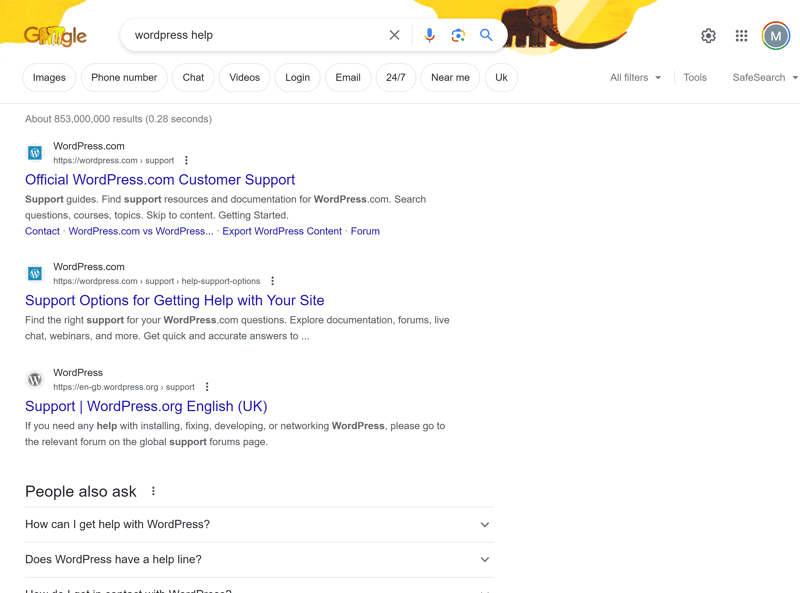
A Google search for "WordPress support" yielded around 360 million results, whereas "Webflow support" only returned around 10 million hits.
Answers to any WordPress question can be found online in just a few clicks. At the same time, this is only appealing to do-it-yourself types, and there isn't any "personal" WordPress support.
How is Webflow's Support?
In contrast, Webflow offers traditional support channels: You can submit a ticket and receive a direct response from the Webflow team, which is active 12 hours a day, Monday through Friday. In our test, we received a detailed and personalized response tailored to our questions in our inbox after about 7 hours, which is perfectly acceptable.
However, Webflow's most valuable support resource is Webflow University. It contains hundreds of courses and videos that explain most of Webflow's features, as well as the basic principles of web design and programming. Beginners wanting to learn how to use Webflow will find everything they need here.
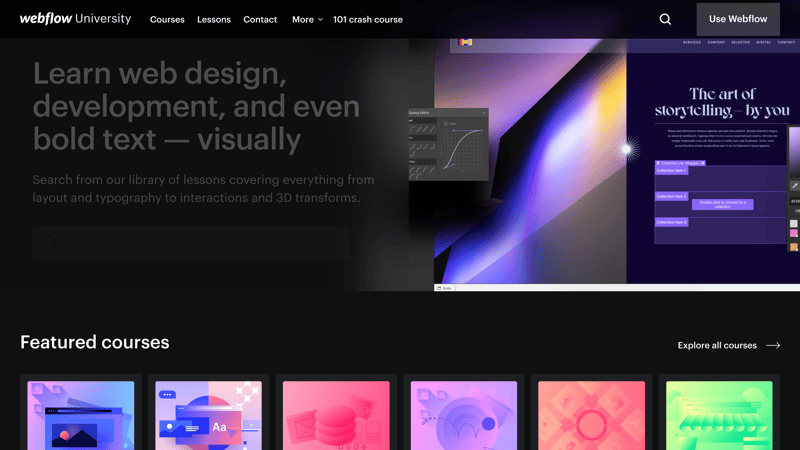
While the Webflow community is smaller than WordPress's and there are fewer tutorials scattered across the internet, you don't need to search the web for these resources: Webflow provides all the support and documentation you need.
WordPress doesn't come with support, and you'll need to solve any issue or problem on your own — which, thanks to the wealth of support content available online, is quite easy to do. Webflow, on the other hand, offers fast and reliable direct support, as well as an excellent help center with comprehensive courses and tutorials.
Result: Which Platform Is Better?
So, which is better – WordPress or Webflow? The (admittedly somewhat boring) answer: it depends. The two platforms have different strengths and weaknesses and cater to different target groups.
Who Is WordPress For?
WordPress is the better choice if you're looking for a user-friendly website platform that offers maximum flexibility and customizability. Users of all experience levels can create all kinds of websites with it, from small blogs to large corporate websites and online stores. The selection of themes and plugins is vast, and there's likely a suitable integration for just about any service.
For beginners, there's certainly a learning curve, but it's not as steep as Webflow's – especially for users with no web design or programming skills. With a wide range of hosting services, WordPress is also suitable for nearly any budget.
WordPress Pros and Cons
Unlimited possibilities
WordPress offers nearly unlimited options when it comes to customizing and designing a website. From straightforward blogs to sprawling online stores, you can use it to create nearly anything.Gentler learning curve
WordPress is user-friendly and ideal for beginners who lack in-depth programming or web design knowledge. However, the more expertise you have, the more you'll be able to create.Suitable for any budget
You have a wide choice of hosting plans, catering to all budgets.Countless plugins and themes
WordPress's theme and plugin libraries are vast. You should be able to find a suitable extension for any design and functionality.
Technical management not included
You are responsible for hosting, security, and maintenance of your website.Many important features require plugins and extensions
While Webflow comes with everything you need to get your website going, WordPress often requires additional plugins, integrations, or custom-built solutions.No support
WordPress does not offer any direct support. You'll need to consult the community or use external sources (of which there are many).Full potential reserved for professionals
To take advantage of everything that WordPress has to offer, advanced web development and design knowledge are required.
Who Is Webflow For?
Webflow, on the other hand, is ideal for users seeking a more intuitive, design-oriented platform. Its primary audience includes designers and creatives who value visual design and want precise control over their website's layout.
Unlike WordPress, Webflow also has the advantage of being an “all-in-one” solution, with hosting and technical management included in the package. The platform is optimal for medium to large projects where design is a priority and less technical background is available.
Webflow Pros and Cons
Powerful editor that visualizes programming
Webflow comes with a fantastic editor that enables complex web design even without programming knowledge. Those who master it can save a lot of time — and might swear by it over time.All-in-one subscriptions
Hosting, domain, and technical management are included in the service, making the admin of it all a bit easier.Good support and excellent documentation
Webflow provides direct customer support and extensive help content in the Webflow University.
Steep learning curve
The editor is somewhat more complex and requires a period of familiarization, especially for users with little knowledge of web design principles.Less flexible (than WordPress)
Webflow is overall less flexible than WordPress because it offers significantly fewer features, integrations, and extensions. The selection of themes is limited, and there aren't any plugins.
Conclusion
Do you want to create a website and don't know whether WordPress or Webflow is the better platform for you? Both solutions offer unique strengths but cater to slightly different target groups.
WordPress is probably the most versatile solution on the market and a good choice for users of all experience levels and projects of different budgets. Even beginners without design and programming knowledge can quickly start working on their first websites, while advanced users benefit from almost limitless customization. However, keep in mind that you'll have to take care of aspects like hosting yourself.
Webflow, on the other hand, is a suitable alternative for users who already have some web design experience and prefer a visual and design-oriented approach for their web projects. Because hosting, technical management, and support are integrated, you don't have to worry about anything else.
Both WordPress and Webflow are a bit too complicated for what you're trying to do? In that case, a simple website builder might do the job. We reviewed 12 of the most popular website builders on the market to help you find the right platform for your needs.

















